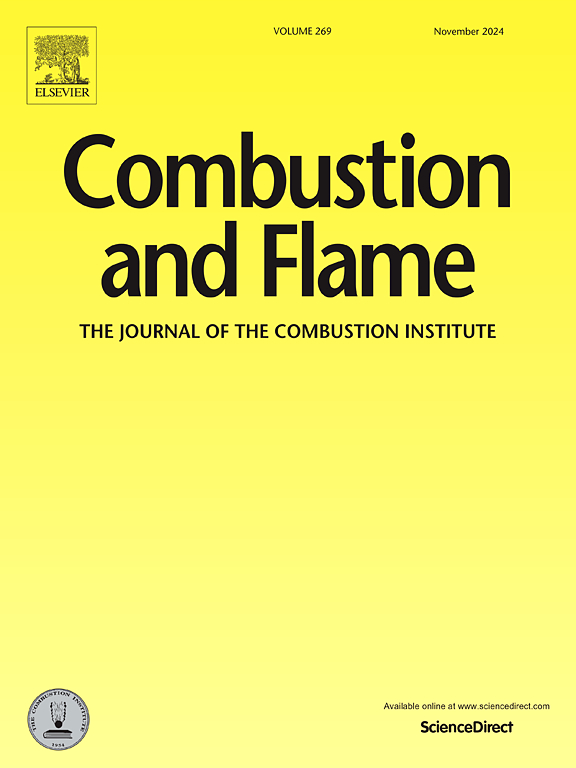High-temperature ignition of ammonia/methyl isopropyl ketone: A shock tube experiment and a kinetic model
IF 5.8
2区 工程技术
Q2 ENERGY & FUELS
引用次数: 0
Abstract
The ignition delay times (IDTs) of NH3/methyl isopropyl ketone (MIPK) mixtures with MIPK blending ratios of 5 %, 10 %, and 30 % were measured at pressures of 1.75 and 10 bar, temperatures ranging from 1100 to 2000 K, under stoichiometric condition. The IDTs were found to exhibit a sharp decrease at 5 % MIPK blending ratio and then reduced slowly with further MIPK addition. Increasing pressure could enhance the ignition-promoting effects of MIPK. A detailed MIPK-NH3 model was constructed including the MIPK sub-model, the NH3 sub-model, and the cross-reactions between C-containing species and N-containing species which consisted of the prompt NO formation reactions and reburn type reactions, the recombination and oxidation reactions of small amines, H-abstraction reactions, and disproportionation reactions. The predictions calculated by the MIPK-NH3 model are in good agreement with the measured IDTs. The analysis showed that the cross-reactions evidently inhibit the ignition of NH3/MIPK, which is mainly attributed to the disproportionation reactions; and the ignition-inhibiting effects decrease with the increasing pressure or MIPK blending ratio. The effects of the MIPK blending ratio and cross-reactions on the ignition of NH3/MIPK were analyzed in detail. The oxidation pathways of NH3/MIPK were also discussed.
氨/甲基异丙基酮高温点火:激波管实验及动力学模型
在化学计量学条件下,测定了NH3/甲基异丙基酮(MIPK)混合物(MIPK掺量为5%、10%和30%)在压力为1.75 bar和10 bar、温度为1100 ~ 2000 K下的点火延迟时间(IDTs)。在MIPK掺量为5%时,IDTs急剧下降,随着MIPK掺量的增加,IDTs逐渐下降。增加压力可以增强MIPK的促燃作用。构建了详细的MIPK-NH3模型,包括MIPK子模型、NH3子模型以及含c和含n之间的交叉反应,包括快速NO生成反应和再燃烧反应、小胺的重组和氧化反应、吸氢反应和歧化反应。由MIPK-NH3模型计算的预测结果与实测的idt吻合较好。分析表明,交叉反应明显抑制NH3/MIPK的着火,这主要是由于歧化反应;阻燃效果随压力或掺混比例的增加而降低。详细分析了混合配比和交叉反应对NH3/MIPK着火的影响。讨论了NH3/MIPK的氧化途径。
本文章由计算机程序翻译,如有差异,请以英文原文为准。
求助全文
约1分钟内获得全文
求助全文
来源期刊

Combustion and Flame
工程技术-工程:化工
CiteScore
9.50
自引率
20.50%
发文量
631
审稿时长
3.8 months
期刊介绍:
The mission of the journal is to publish high quality work from experimental, theoretical, and computational investigations on the fundamentals of combustion phenomena and closely allied matters. While submissions in all pertinent areas are welcomed, past and recent focus of the journal has been on:
Development and validation of reaction kinetics, reduction of reaction mechanisms and modeling of combustion systems, including:
Conventional, alternative and surrogate fuels;
Pollutants;
Particulate and aerosol formation and abatement;
Heterogeneous processes.
Experimental, theoretical, and computational studies of laminar and turbulent combustion phenomena, including:
Premixed and non-premixed flames;
Ignition and extinction phenomena;
Flame propagation;
Flame structure;
Instabilities and swirl;
Flame spread;
Multi-phase reactants.
Advances in diagnostic and computational methods in combustion, including:
Measurement and simulation of scalar and vector properties;
Novel techniques;
State-of-the art applications.
Fundamental investigations of combustion technologies and systems, including:
Internal combustion engines;
Gas turbines;
Small- and large-scale stationary combustion and power generation;
Catalytic combustion;
Combustion synthesis;
Combustion under extreme conditions;
New concepts.
 求助内容:
求助内容: 应助结果提醒方式:
应助结果提醒方式:


